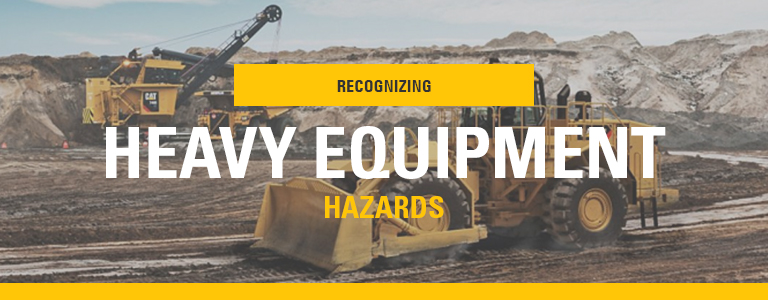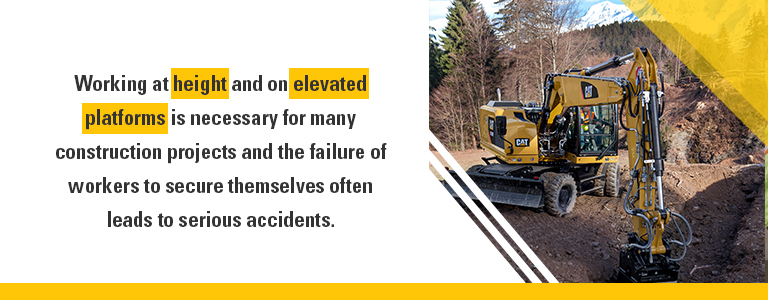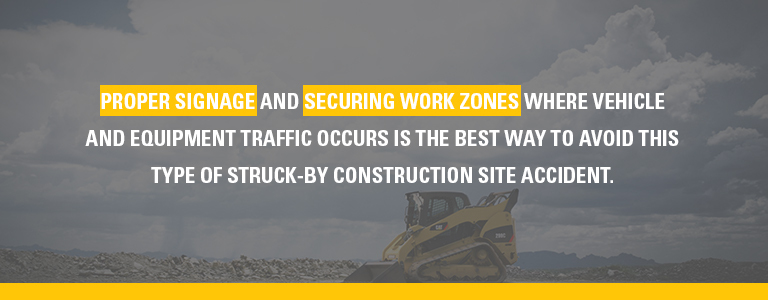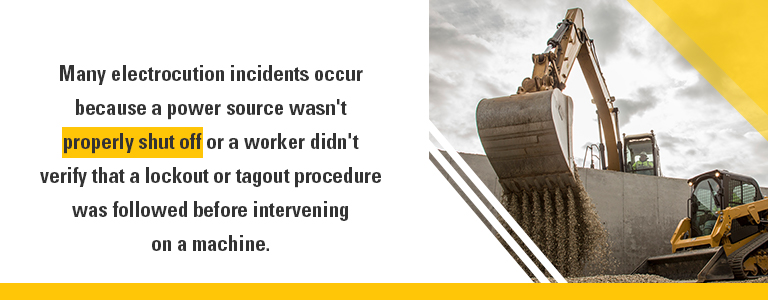Recognizing Heavy Equipment Hazards
It takes a fleet of heavy equipment to get big jobs done. Loaders, excavators, dozers, earthmovers and material handlers all make construction sites work. The sheer size and power of these large pieces of machinery also make a construction site a potentially dangerous place for workers. To reduce construction site safety risks, you and your workers need to be aware of the potential dangers and recognize heavy equipment hazards.
Here at Western States Cat, you can take advantage of our experience and Cat® heavy equipment knowledge to improve your work zone safety and increase awareness of the risks involved in construction work zones. We have identified four major hazard areas that you need to identify on your site so you can incorporate them into your worker safety training program:
Falling Accidents
Falls are some of the most common construction site hazards. Working at height and on elevated platforms is necessary for many construction projects and the failure of workers to secure themselves often leads to serious accidents. A fall from even a moderate height can lead to injury and a fall from a greater height can lead to death.
Construction fall safety involves:
- Identifying potential fall zones and areas
- Labeling dangerous areas as fall hazards
- Installing safety barriers along elevated work zones
- Ensuring all gates and doors latch or lock properly
- Equipping and training workers to use safety harnesses
Remember that working at height doesn’t necessarily mean on a crane, telehandler or another aerial work platform. Work-at-height is defined as any time you are working above floor or ground level and could fall off an edge. Even working a very short distance from the ground, on the edge of a beam or on unsure footing, could lead to injury if a worker slips off the edge and falls down. Remember that low barriers (such as berms, wall footings and low concrete barriers) can become trip hazards, leading to a fall, if a taller railing isn’t present.
Workers on multi-floor buildings are at high risk of falls, especially on projects where doors and windows are being installed and barriers have to be removed as the windows and doors are going in. Never remove multiple barriers in anticipation of installation — only remove the barrier at the opening you are working on at the moment. Removing all barriers on a floor with many windows to be installed, for example, can lead to a fall if the work isn’t completed right away and workers come back later and aren’t aware the barriers have been removed.
Some workers also find safety harnesses cumbersome when they are working in cranes and aerial work platforms and remove them. Train workers to keep their safety harness attached at all times while working, as a fall can occur in a split second. If workers complain of restrictive safety harnesses, investigate to ensure they are using them properly and that the harnesses are the right safety equipment for the job at hand.
Struck-By Accidents
A struck-by construction accident occurs when a worker comes into contact with a moving object or falls onto a stationary object. Some of these accidents occur between a vehicle or moving equipment and a worker:
- Equipment operator running into a worker on foot
- Striking a worker with a crane boom or load
- Failing to set a parking brake properly
- Failing to properly use wheel chocks
Proper signage and securing work zones where vehicle and equipment traffic occurs is the best way to avoid this type of struck-by construction site accident. Train employees to watch for workers when operating equipment and for workers on the ground to watch for moving equipment and vehicles. Use the “eye-contact rule” for busy work zones: Workers must make eye contact with equipment operators before proceeding into their work zone.
While these struck-by safety concerns are typically the most severe, there are many other cases where workers are struck by objects and seriously injured. This type of accident includes any case where a tool, piece of a machine, debris or other projectile strikes a worker. Some common examples include:
- The head of a hammer flying off the handle
- A saw blade breaking or snapping off
- Brick, concrete or other debris being projected
- A cut piece of rebar, bolt or wood flying off after cutting
Using tools properly reduces the likelihood of this type of accident. Keep saw blades in good repair and only engage as much of the blade as necessary. Check tools with handles (hammers, axes, chisels, etc.) to ensure the heads are securely fastened. Provide protective equipment and screens in areas where workers are blasting, hammering, chiseling and creating loose-flying debris. You can reduce struck-by accidents by enforcing PPE usage (goggles, face shields, helmets, etc.), as many incidents involve small debris being projected at workers’ eyes.
Safe work practices don’t occur by chance. You need to instill a culture of safety at your construction site so workers can easily identify potential struck-by risks, reduce potential exposure and avoid becoming another workplace accident safety statistic. Offer heavy equipment vehicle operators general training as well as instruction on smaller equipment and tools that may seem intuitive but come with a host of safety features and operating limits that need to be understood.
Caught-Between Accidents
Caught-between accidents almost always cause injuries that lead to lost work time and, in some cases, can lead to permanent disability or death. A large percentage of caught-between workplace incidents are vehicle-worker accidents where the operator of a vehicle didn’t see a worker and pinned them. Some common examples are:
- Crushing a worker against a building or other piece of equipment
- Pinning a worker against a wall or fixed object
- A worker getting pinched in parts of a moving machine
Once a worker is caught in a situation like this, simply reversing may not be enough to avoid serious injury. That’s why avoiding caught-between workplace accidents is critical for ensuring worker safety. This type of accident can also occur in confined spaces, where workers become trapped in or between surfaces such as:
- Trapped in a container or room
- Caught in a narrow passage
- Pinned between piles of materials or debris
- Sandwiched between trench walls and pipes or other materials
- Caught by fallen materials or equipment
Unfortunately, many caught-between workplace injuries are a result of failing to follow workplace safety rules or bypassing safety features and protections in an attempt to save time. For example, in trenching and digging operations, it is highly recommended that you install safety barriers that prevent cave-ins or being caught between materials (pipes, foundation materials, beams, etc.) and the trench walls. Many work sites forgo these safety steps to work faster, creating dangerous working conditions for workers.
Ask workers to observe their surroundings at all times and always have an exit planned in case of an accident. Teach them not to work between a piece of equipment and a fixed object (like a wall, fence or pile of material). Remind workers that a typical construction site is a dynamic place and that potential caught-between locations can change as equipment, vehicles and materials are moved about. Reassess frequently to ensure workers are not working in caught-between areas and make changes as required. As much as possible, have workers perform tasks in groups of two or more so they can be on the lookout for each other instead of leaving isolated workers off by themselves.
Traffic control procedures also go a long way toward reducing vehicle-related caught-between accidents. Traffic flaggers controlling the movement of heavy equipment, for example, can help both equipment operators and workers on foot avoid collision and injury. Efficient rigging operations can also improve your construction site safety and help workers avoid dangerous situations and injuries.
Electrocution Accidents
While the likelihood of electrocution is lower than the other construction site hazards we have mentioned, it is one of the most serious. Electrocution is defined as a lethal amount of electrical energy. An electric shock isn’t necessarily lethal but can lead to serious injury, including severe burning and cardiac arrest. Many electrocution incidents occur because a power source wasn’t properly shut off or a worker didn’t verify that a lockout or tagout procedure was followed before intervening on a machine.
Some examples of workplace errors that can lead to electrocution include:
- Frayed or patched wires
- Disabled security devices
- No lockout or tagout procedure
- “Temporary” repairs to wiring and switches
- Incorrect wiring, sockets and equipment power ratings
- Standing water around equipment and extension cords
- Failure to identify power lines when using cranes and buckets
- Failure to identify underground power lines
If a worker contacts a live wire, they can receive a debilitating shock. If they are able to release the equipment or tool, they may be spared more serious injury. But in some cases, the worker becomes trapped and is unable to break free. This occurs in situations such as:
- Gripping a live wire or steel component, where the body involuntarily causes the hand to grip harder
- Sitting in a vehicle or piece of equipment that becomes electrified
- Falling into or onto an electrical panel or exposed wires
Construction site safety statistics show that electrical injuries are on the rise due to pressures to reduce costs, work faster and cut corners. Buck this trend by putting in place adequate construction site electrocution prevention today.
Take workplace electrocution risks seriously. You want to get the job done, but you also want your workers to go home safe. Perform regular checks of your electrical equipment to ensure that all wires, fuses, safety devices and other electrical protections are in place and functioning properly. Ensure that an electrical lockout or tagout procedure is in place and being followed at all times. Train crane and bucket operators to watch for overhead wires and to take care when digging to identify buried wires. Teach your employees to assume that every wire is live and a potential electrocution hazard until they have positively verified that the power is cut.
Western States Cat Is Your Trusted Partner
With decades of experience, going the extra mile is in our DNA here at Western States Cat. That includes sharing our equipment and work site safety knowledge with you. When you purchase construction equipment form us, we take the time to explain how the equipment works, what the limits are, and what safety features and devices are present.
We invite you to contact Western States Cat to speak with one of our equipment experts about all of your equipment and service needs. Not only can we help boost profitability with our complete lineup of proven Cat machines, but we can also give you tips and pointers on how to keep your workplace safer. No one wants to deal with the tragedy, upset and cost of a workplace accident that leads to worker injury or death, so start by recognizing heavy equipment hazards today and creating a safe work environment for your whole team.



